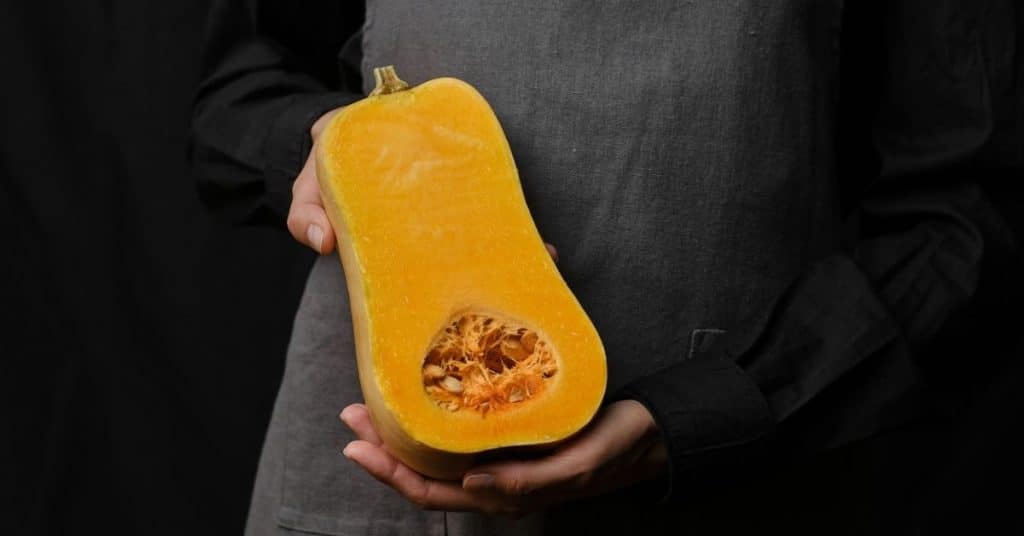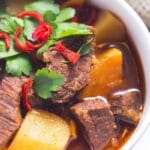In a nutshell: Yes, you can freeze butternut squash, either raw or cooked. It’s recommended to blanch it before freezing to preserve its quality and nutritional value.
Although butternut is commonly considered and used as a vegetable, it is actually botanically classified as a fruit.
This delicious orange squash is versatile for use in both savory and sweet dishes which makes it a great ingredient to have around at all times.
The great thing about butternut is that it freezes well whether raw or cooked. This means you can keep leftovers, prepare butternut squash recipes in advance for a quick-fix meal, or freeze an extra butternut squash you don’t need immediately to avoid waste and save money.
Here is everything you need to know about freezing butternut squash.
Can Butternut Squash Be Frozen?
Yes, butternut squash freezes well whether raw or cooked. Butternut squash will undergo slight changes on freezing resulting in a less firm texture, however, since butternut is mostly eaten cooked, the changes won’t be very noticeable.
As with most fresh vegetables, it is best to blanch butternut squash before freezing. Blanching the butternut in boiling water restricts the natural ripening enzyme activity which causes deterioration in color, flavor, and nutritional value.
Butternut squash that has been blanched will, therefore, last longer at a better quality in the freezer.
If you are planning to use the frozen butternut within 4 months of freezing, blanching is not necessary.
Butternut should not be frozen if it is not ripe, nor if it is of poor quality, showing signs of deterioration or nearing its expiry. The below methods can be used to freeze most types of winter squash.
How To Freeze Raw Butternut Squash
Step 1: Clean
Wash and peel the entire butternut squash, cutting off the top and bottom ends.
Step 2: De-seed
Cut the butternut in half lengthways and remove the seeds and strands by scraping them out with a spoon.
Step 3: Chop
Cut the butternut into the desired size pieces either cubed, in thick slices, or cut into fries.
Step 4: Blanch
This step is optional and recommended if you are planning on keeping the butternut frozen for longer than 4 months.
Heat a pot of water till boiling. Fill a separate bowl with ice water. Throw the butternut squash into the boiling water and start timing once the water starts to boil again.
Small butternut cubes will only take 3 minutes to blanch, while larger chunks will take 5 minutes.
You do not want the butternut squash pieces to cook through, so remove them from the hot water immediately after the three to five minutes of boiling time and submerge them directly into the ice water to stop the cooking process.
Step 5: Dry
Once cold, remove the cubed butternut from the water and dry with a clean kitchen towel.
Step 6: Flash Freeze
Spread the butternut pieces in a single layer on a cookie sheet lined with parchment paper. Place it in the freezer until just frozen.
This quick-freeze process prevents the butternut pieces from sticking together in a clump, allowing you to remove just as much as you need from the freezer at a time.
Step 7: Pack
Remove the baking sheet from the freezer and pack the frozen pieces into resealable freezer bags. Press out as much air at the top of the bag as you can and seal.
Step 8: Label and Freeze
Label the freezer bag so you know how long the butternut squash has been stored and place it in the freezer.
How To Freeze Cooked Butternut Squash
Step 1: Cool
Regardless of whether the butternut squash has been cooked as mash or cubes, cool it down completely before preparing to pack.
Step 2: Pack
Once cooled, pack the butternut squash into resealable bags in the desired quantities. Press out any remaining air at the top of the bag and seal.
Another simple way to freeze butternut squash puree or mash is in ice cube trays. This makes it perfect to add to smoothies. Simply fill an ice cube tray with the butternut squash puree and freeze. For larger portions, use a muffin tins lined with plastic wrap to prevent sticking.
Once frozen, remove the butternut ice cubes from the ice cube trays and pack them into a freezer safe bag or container. If you use a bag, press out any excess air, and seal.
Step 3: Label and Freeze
Label the bags with the date and place the frozen squash cubes or cooked pieces in the freezer.
How To Thaw Frozen Butternut Squash
Raw butternut squash is best cooked from frozen. Remove the frozen butternut squash cubes or slices from the freezer bag, drizzle with olive oil, season, and place them in the oven directly for roasting.
Cooked butternut can be placed in the refrigerator to thaw overnight. To speed up defrosting, you can also place the sealed bag in lukewarm water for a few minutes.
Butternut squash soup or pureed squash can be reheated from frozen on the stovetop, or placed in a microwave safe bowl, covered, and microwaved using the defrost setting. Stop to stir the soup in the microwave at 60-second intervals to ensure even heating.
Types of Butternut Squash
Butternut squash, also known as butternut pumpkin or gramma, comes in different varieties. However, all types of butternut have an orange hard fleshy interior with a compartment of seeds towards the bottom center. The shade of orange may vary according to the variety.
Butternut is popularly prepared in a variety of ways including roasted, sautéed, puréed into soup, mashed, fried, halved, and stuffed, incorporated into salads, mixed into batters for muffins, bread, and even into dessert pie fillings.
Its sweet nutty flavor intensifies as it ripens and when it is cooked.
Butternut seeds can also be toasted and are edible. The skin is generally removed but if well cooked, it softens and is edible.
FAQs
Conclusion
Whether eaten as a mash, fried, stuffed, roasted, or baked into muffins, butternut squash is a delicious veggie and so versatile that it can even be sneaked into desserts. You can successfully freeze squash with its flavor and color remaining mostly unchanged.
Whether you are saving leftovers, saving money by buying winter squash in bulk, or doing meal-prep for convenient week-night dinners, freezing butternut squash is easy and very worthwhile.
Don’t forget to check our other guides on how to freeze pumpkin pie and canned pumpkin puree.
*image by lohvynenko/depositphotos









